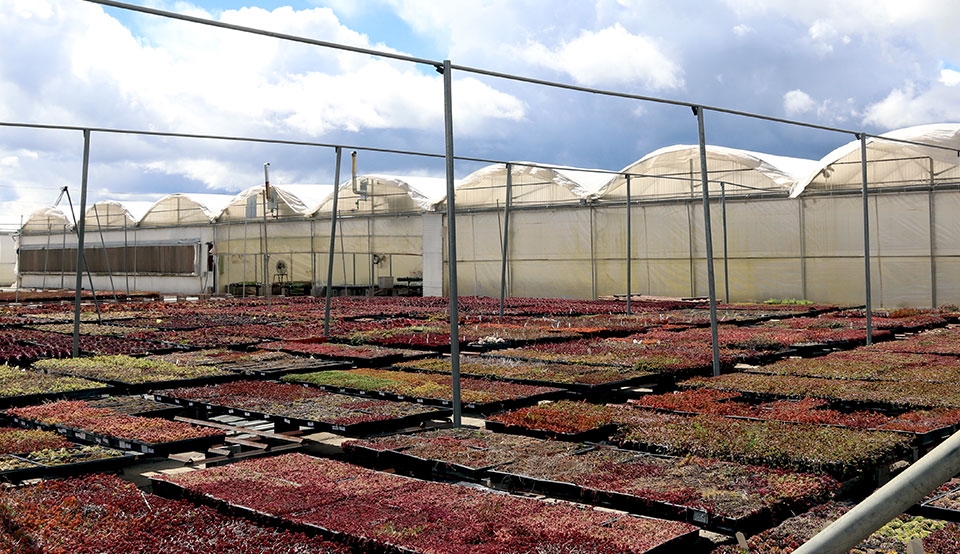Product Details
Highlights
Aloe 'Pink Blush' (Griffin): A small, clumping Aloe with bumpy, textured leaves. It's mottled with dark and light green pigments and has pink, toothy edges. At maturity, it can reach 1.0' wide and tall and produces tubular, coral blooms in late winter to spring.
Soft succulents will not survive a hard frost, but if there is a risk of freezing temperatures they can be brought indoors to grow on a sunny window sill or under a grow light. They need bright sunlight, great drainage, and infrequent water to prevent rot. Pick containers with drainage holes and use well-draining cactus and succulent soil with 50% to 70% mineral grit such as coarse sand, pumice, or perlite. Water deeply enough for water to run out the drainage hole, then wait for the soil to fully dry before watering again.
Product Size
2.0" Pot
Current Primary Color
Pink
All Seasonal Colors
Green
Bloom Color
Orange Bloom
Grow Zone (Hardiness)
Zone 10 (30F)
Recommended Light Conditions
Bright Indoor Light, Full Sun
Maximum Height
9"-12"
Maximum Rosette Size
Over 8"
Growth Habit / Shape
Loose Rosette
Seasonality
Year-round Color
Special Characteristic
Easy to Propagate, Showy Blooms

THIS PLANT IS HARDY IN ZONES 10+
WHAT IS MY HARDINESS ZONE?
Videos
Questions & Answers
none
Popular Questions

Although we don't keep the shade cloth over them in the fall, when this picture was taken, those metal frames you see allow us to create a roof of shade cloth over all of the plants. There's plenty of room for people, and even forklifts, to move under the shade cloth and work among the plants and they don't get sunburned.
See full answer »
Shop Succulent Soil Here
Succulents need grittier soil than other plants because they are adapted to dry conditions and store water in their leaves. Regular potting soil mixes stay damp for long periods of time, which can cause rot in succulents. Instead, use a sandy, well-draining soil so you can water thoroughly without leaving your succulent in standing water.

IN POTS…
See full answer »Our plants can be transplanted immediately upon arrival.
If you want to wait to transplant, they can remain in their original containers for up to a month. If the pots came in a plastic carrier tray, remove the pots from the carrier tray prior to the first watering.
Keep the plants indoors near a sunny window or outdoors under a roof (only if outdoor temperatures stay above your succulent's minimum hardiness temperature). Water only after the soil is fully dry by drenching from above with a faucet, hose, or watering can. Gently shake excess water from the leaves and allow containers to drain completely.
See full answer »Fertilizing is not necessary, but it is a good option for succulent growers who want to encourage faster, larger growth. It can be used on mature plants with established roots. Only fertilize in the growing season (spring and summer for most varieties) to avoid weakening or burning dormant plants. Use a light touch and make 2-3 applications of low-Nitrogen, diluted fertilizer each year (N-P-K ratio around 5-10-10). You can find specially-formulated cactus / succulent fertilizers in most garden centers or go organic with compost tea or bone meal.
Example: Miracle-Gro Quick Start, diluted to half strength
See full answer »Succulents need deep, infrequent watering, especially during their growing season and when they are young and establishing roots. Only water after the soil is completely dry and the plant feels less firm. Err on the side of underwatering. Watering too frequently is the most common way to kill succulents.
HOW TO WATER SUCCULENTS
- Drench from above using a faucet, hose, or watering can
- Do not mist with a spray bottle (the only exception is for Air Plants)
- Water until it drains from the container's drainage hole. If your container does not have a drainage hole (not recommended), use about 1/3 the volume of the container…
Different succulent varieties have different light needs. You can find the Recommended Light Conditions on each variety's page by scrolling down to the Product Details. We use four categories of recommended light, and some plants can thrive under a range of light conditions.
LOW INDOOR LIGHT
- Can grow indoors without direct sun.
- Placing outdoors in direct sun or on sunny window sills might cause dark burns.
- There are a limited number of succulent varieties that thrive in low light, notably Haworthia, Gasteria, Peperomia, and some Jade…
Many succulent varieties are only available seasonally because of their growing and propagation cycles. During the growing season, we can usually restock sets and trays weekly. Most individual plants will go in and out of stock through the seasons, but they are also restocked weekly when available. Thursday is usually the best day of the week for finding plants in stock. Spring and Summer are generally the best seasons for availability.

Any product that is out of stock has an "Email me when a product is back in stock" button (shown above). Click the button and enter your email to be notified when it's available again. If this button isn't appearing, the plant may have very recently sold out - check back after a short while and the button should appear.
See full answer »- Using very gritty succulent soil and pots with drainage holes
- Providing lots of sunlight and airflow




![Aloe 'Pink Blush' [large] - February](https://cdn11.bigcommerce.com/s-oqm1pc/images/stencil/631x631/products/2919/24486/aloe_pink_blush_1__94077.1690917005.jpg?c=3)


![Aloe 'Pink Blush' [large]](https://cdn11.bigcommerce.com/s-oqm1pc/images/stencil/631x631/products/2919/20497/aloe_pink_blush2__41942.1642616559.740.740__91716.1684172157.jpg?c=3)
![Aloe 'Pink Blush' [large]](https://cdn11.bigcommerce.com/s-oqm1pc/images/stencil/631x631/products/2919/20498/aloe_pink_blush__71941.1642616559.740.740__58120.1684172157.jpg?c=3)


![Aloe 'Pink Blush' [large] - February Aloe 'Pink Blush' [large] - February](https://cdn11.bigcommerce.com/s-oqm1pc/images/stencil/128x128/products/2919/24486/aloe_pink_blush_1__94077.1690917005.jpg?c=3)


![Aloe 'Pink Blush' [large] Aloe 'Pink Blush' [large]](https://cdn11.bigcommerce.com/s-oqm1pc/images/stencil/128x128/products/2919/20497/aloe_pink_blush2__41942.1642616559.740.740__91716.1684172157.jpg?c=3)
![Aloe 'Pink Blush' [large] Aloe 'Pink Blush' [large]](https://cdn11.bigcommerce.com/s-oqm1pc/images/stencil/128x128/products/2919/20498/aloe_pink_blush__71941.1642616559.740.740__58120.1684172157.jpg?c=3)









